|
Milton - 'up enders' and
'down enders'
One of Stoke on Trent’s most historic sites is the ancient abbey at Hulton. The remains of this former monastery, home to the Cistercian monks of St Mary in 1223, lie overgrown but unruffled by the modern world that races by along the adjacent Leek Road.
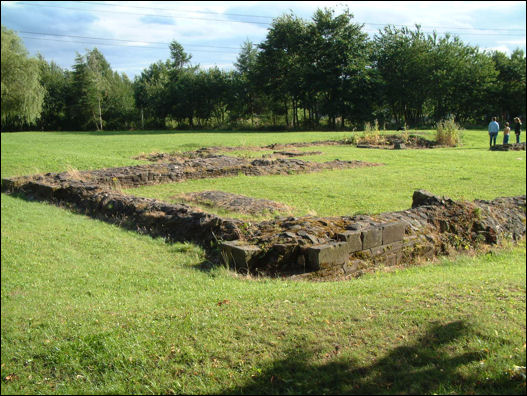
remains of the wall
of Hulton Abbey
The Lordship of Hulton originally comprised 1400 acres of land and included the village of Milton. Here the craggy high land falls to the level of the River Trent which was then faster flowing than it is today. Much use was made of its currents in the erection of a number of mills in the undocumented period before the arrival of the monks. Famously there was a mill at Milton even though it hasn’t been seen in a lifetime. I used to think that Milton took its name from this mill but it doesn’t, it actually takes its name from a Norman landowner named Nicholas de Mulneton who was granted ownership by Edmund de Stafford the grandson of Richard de Toeni the first baron of Staffordshire and a really good mate of William the Conquerer.
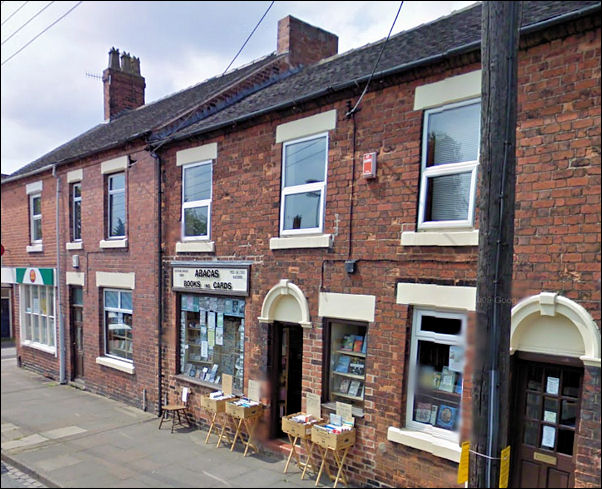
Abacas Bookshop,
Millrise Road, Milton
Google Street View
This brief history lesson was handed down to me by Dave Mycock, the owner of Abacas Bookshop in the centre of Milton village. Dave came to reside in Milton 24 years ago and expanded his business by knocking the insides of three terraced houses together. Most antiquarian book collectors will tell you that Dave has become the seminal source for local history books but sadly Abacas is the last second-hand bookstore left in Stoke on Trent. Although Dave maintains the steady custom of bibliophiles and manuscript devourers these days his main trade is processed through stationery and greetings cards.
“Car boot sales have had a detrimental effect,” he says. “And in charity shops there’s a great deal of activity. I suppose some bargains can be picked up. But so far as second-hand books are concerned the internet has gobbled up most of the dealing. There is a website called Abe Books where most of the good stuff is traded.”
I ask Dave if he would trade on the internet bearing in mind that if he does it would effectively remove the last of the City’s second-hand bookshops. “I’m looking into it,” he responds objectively, reassuring me with a sly smile, “But I’ll still keep the shop going.” However he does concede that without the sales of greeting cards he would probably have to close immediately, “That’s my bread and butter,” he says.
Booksellers like Dave should be a protected group. Like the wildlife that used to be a prominent feature around these parts Dave is one of a fast disappearing species except that his demise is down to electronic motherboards triggered by the touch of a mouse rather than irresponsible environmental erosion caused by the encroachment of housing.
Dave was kind enough to lend me a sample copy of a local book, ‘Milton Memories,’ produced and written by villagers Florence Chetwin and Margaret Reynolds. Florence is 87 and unfortunately I wasn’t able to meet up with her but I did manage a conversation with her via the Abacas shop’s telephone.
Florence and her ancestors have lived in Milton for generations. The cottages in Market Street, now Millrise Road, are long gone but there were once so many of Florence’s clan that locals renamed the street Chetwin Row. Her grandfather Frank Coppick was landlord of the Foxley Hotel for forty years. In her book Florence remembers visiting the famous pub as a child.
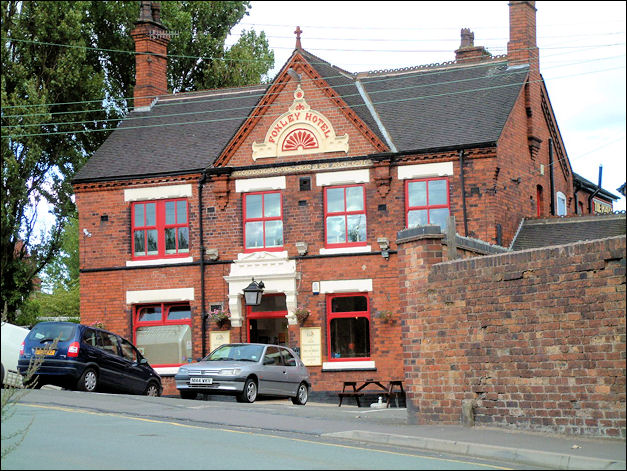
Foxley Hotel, Milton - on
the banks of the Caldon Canal
“They always had a cooked tea at the Foxley,” she recalls, “Kippers, soused herrings or tripe and vinegar. If it was a kipper there’d be squares of newspaper at the side to put the bones on and to wipe our fingers with.”
She remembers the village junior school and its building expansion to include outlying districts because of the hundreds of new council houses built in the vicinity after the war. This was the time Milton was effectively compelled to open its doors to outsiders. “Virtually overnight,” Florence’s book explains, “The school’s population almost doubled. From knowing everyone in school we found ourselves suddenly surrounded by strangers.”
Reading this fascinating manuscript illuminates the sociological changes in post-war Milton when city housing became a serious priority and, like many similar villages, Milton became suburbanised. This once historic and pretty backwater suddenly had to make room for a wider community as families were relocated to the countryside from pre-war slums, a policy that included miners who were arriving from the North East and Wales. It must have been strange for the former villagers to have to get used to Northumberland twang and Welsh lilt not to mention the hard-nose Potteries industrial dialect.
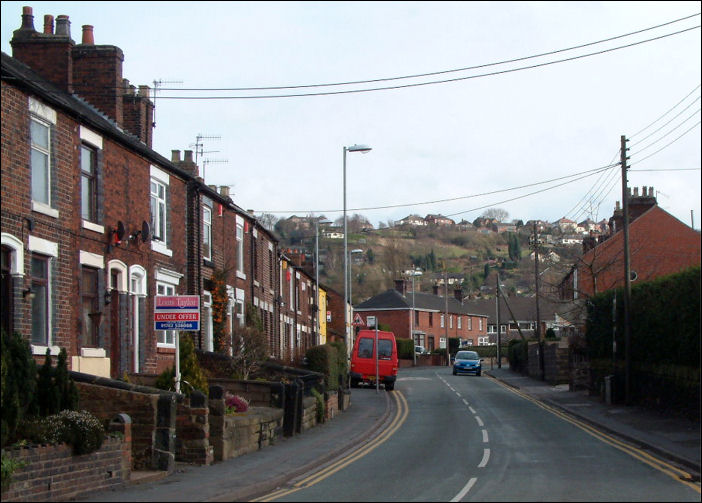
Milton - the 'up
end'
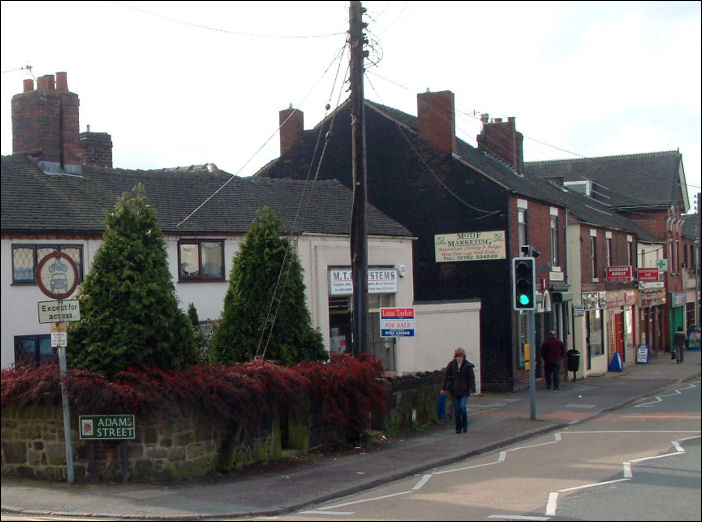
Milton - the 'down
end'
Nevertheless there are still many people who have lived all their lives in Milton. One such villager is Gill Regan, originally a ‘top-ender’ as those that lived on the east side were called, whose grandmother owned a house in Bagnall Road. Gill was brought up as a ‘top-ender’ but Florence Chetwin was raised as a ‘bottom-ender.’ According to Florence the village was divided at the crossroads of Leek Road. Florence moved later in life upward – to the top, as it were – over the boundary to Bagnall Road while Gill travelled the other way downwards from Bagnall Road as soon as she was married. Although these two parishioners have exchanged places Gill’s mother still lives in Bagnall Road which, I suppose, probably qualifies Gill to hold a dual passport.
“When I was a child everyone knew everyone else. It was very much traditional village life,” she tells me. “About thirty years ago the new-build houses started to arrive in earnest and have continued to be built so that Milton really has lost that village feeling. It’s difficult these days to locate the actual boundaries because housing development has altered all the borders.”
Gill’s husband, Patrick agrees. “There are a number of villages around here that use to have their own identity but I think the special geography that once identified them has been lost through town overspill.”
Patrick Regan describes himself as a poetry researcher. In fact he is more than that having published a number of his own novels about Stoke on Trent on the internet.
Milton is certainly recognised as a fount for artistic generation. For one thing it was the birthplace of John Cope whose prodigious talent was recognised by his tutor Madame Marie Reymond to become possibly the finest concert musician the Potteries have ever produced. At a young age Cope studied classical organ under the famous 19th century Bavarian maestro Josef Rheinberger and went on to inaugurate the North Staffordshire Symphony Orchestra of which he was the conductor and director for many decades.
Patrick Regan is a Longtonian who moved to Milton when he married Gill. They have three sons whose ages range from 24 to 18. Patrick says he’s never been caught up in village life but is very much in thrall to the whole district for its inspirational and visual quality. He has created a website to commemorate the work of George Heath the so-called Moorland poet. Heath lived nearby in the village of Gratton from 1844-1869 and his life story appears to run in allegorical simulation in sad detail to the life of John Keats. Keats’ tragic love for Fanny Brawne foretells Heath’s own unrequited love lost through betrayal by an unidentified girl mysteriously referred to as Jenny. And like Keats, Heath died at the age of 25 having published only two slim volumes of poetry 61 poems in all.
Patrick has wandered all over these parts searching for Heath’s countryside. “You can roam all over,” he says. “And all you’ll do is become more lost. There aren’t any signposts and Gratton is like the shadowy fictional village Brigadoon – permanently lost appearing only when you least expect it. It’s no good looking. It’s like the end of a rainbow – the more you try to reach it the more you will pass it by. It’s poetic myth.”
And there are some myths about Milton I have dispelled. Foremost is that it was not named after the poet John Milton. Neither was it named Mill-Town after its long-forgotten mill that was located near the River Trent but nobody remembers exactly where.
There was of course the famous Bullers of Milton a former pottery that produced between 1903 and 1963 outstanding art works by the Burslem art teacher, Gordon Forsyth, and the perhaps more commercially famous ceramic artist Anne Potts. But that company became an insulator manufacturer in more recent times and now another new housing estate is being built on the site. And jobs in industry were once provided by Milton’s British Aluminium works, a company that disappeared a long time ago – all of it as you may say, gone under houses.
At the northern entrance to the village stands the former railway station house. Like Hulton Abbey the remains of the concrete platform lie overgrown with bindweed and bramble below the closely aligned bridges where also the River Trent and the Caulden Canal flow hidden from roadside view. And yes, I really do get the feeling that Milton village is very much like the mysterious fictional Brigadoon whose inhabitants awaken only once every hundred years. When, I wonder, will that happen again?
Fred Hughes

|
![]()
![]()
![]()